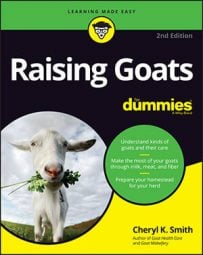Many goat owners keep livestock guardian dogs, donkeys, llamas, or alpacas with goats as full-time guard animals. Guardian animals can add a substantial cost in terms of training and upkeep, but they may be well worth the effort and time if they work out.
Try to get a guardian animal from a breeder who has used the animals for this purpose and can vouch for (but not guarantee) their pedigree, training, and temperament.
Livestock guardian dogs (LGDs) were bred and have been used for thousands of years to protect goats and sheep in Europe and Asia. They live and bond with the goats, are aggressive toward predators, and are focused on the job. These dogs are traditionally white, which enables them to blend in with the sheep flock and be distinguished from predators. Of the many breeds of livestock guardian dogs, the Great Pyrenees is probably the best known. Other common livestock guardian breeds include
Akbash
Anatolian
Komodor
Kuvasz
Maremma
Ovcharka
Shar Planinetz
Slovak Cuvac
Tatra Sheepdog
Don't buy a herding breed such as Australian shepherd or border collie to guard your goats; they aren't qualified. Their job is to herd, and you may have a problem with them chasing goats. That isn't to say that some haven't been successful, just that they are unlikely to do a good job protecting goats.
Donkeys have been used for hundreds of years to guard sheep and other herd animals. They're very intelligent and have good hearing and eyesight. They work better alone and don't like dogs, so they can't work as a team with an LGD. Donkeys' dislike of dogs also makes them effective against coyotes.
Because donkeys are naturally herd animals, if they're bonded to the goats, they can be counted on to stay with them most of the time. Ideally, you get a guardian donkey at birth or as soon as it's weaned to make sure it bonds with the goats. Because they eat the same food as the goats, donkeys also will want to stay with the herd after they realize that's where the food is.
When a guardian donkey becomes aware of a predator, she situates herself between the intruder and the herd and brays loudly. If the animal doesn't leave, she chases it, and if that doesn't work, she attacks by rearing up on her hind legs and coming down on the predator with her front feet.
Llamas and alpacas are good guardian animals because they bond quickly to goats and also eat the same feed. Castrated males make the best goat guardians. Males can injure goats by trying to mount them and can be too aggressive toward humans as well.
Unlike dogs, llamas work better as guardians when they're alone instead of in a pack. A llama and guard dog combination can be trained to work cooperatively, though.
Llamas need strong fences to help them do the job. If a guardian llama can't scare off a dog or coyote with his aggressive attitude, the predator may kill him.

